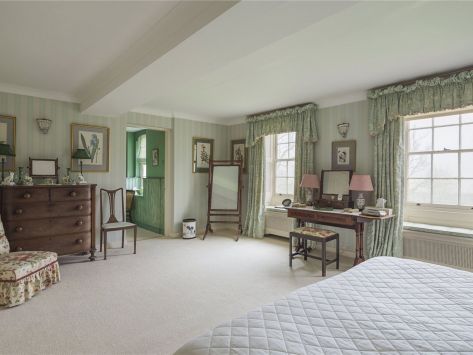A secretive house built on the riches of West Indian sugar plantations and slavery

Country Life magazine describes this house as ‘a fitting addition to the market in Humphry Repton’s bicentenary year’. Dullingham House, near Newmarket, Cambridgeshire, is being marketed by Savills with a guide price of £2.75 million.
The country house is understood to have been built for Sir Christopher Jeaffreson in the early part of the 18th Century – possibly on the site of an earlier house and is a fine example of red brick Georgian architecture, with patterned burnt headers beneath a slate roof.
A look into the history of Dullingham House shows it was likely constructed from the riches of sugar and the slave trade.

In 1878, two volumes entitled A Young Squire of the Seventeenth Century, edited by John Cordy Jeaffreson, made up from the papers of Christopher Jeaffreson (1676-1686) of Dullingham House, were published.
Within these volumes we learn that Christopher Jeaffreson was born in 1650, and that he was in his seventy-fifth year when he died at Dullingham House.
His father was a ‘fortunate adventurer’, one John Jeaffreson, became a landed proprietor in St. Christopher’s Island, and obtained the title of Colonel from his command of the militia on the island. The Colonel became a rich man and among other estates in England, where he spent the last years of his life, he acquired ‘the manorial property and farms pertaining to Dullingham House in 1656 (from the infant Sir Richard Wingfield), so that his son Christopher, the ‘young squire’, on reaching the age of 22, at which he succeeded to his inheritance, ‘had the revenue of an affluent country gentleman, apart from the rents of his West Indian property’.

Christopher married soon afterwards, but his wife soon died, leaving him a disconsolate widower. He set out on a voyage to St. Kitts ‘in order that he might settle and restore his estate on the island’. He ended up staying five years in the West Indies, where he worked energetically as a planter and merchant, and took an active political interest in the colony.
On his death in 1725, the estates in the West Indies and Suffolk passed to another Christopher Jeaffreson, M.P. (1699-1749), the man thought responsible for building the Dullingham House we see today.

At a by-election in 1744 he was returned unopposed for Cambridge on the interest of his friend, Samuel Shepheard. He was replaced by Shepheard at the general election of 1747, but on Shepheard’s death the next year was again returned. He died in 1749, according to William Cole, the Cambridge antiquary, ‘from too much drinking, which brought him into a consumption. He was one of the tallest men I ever saw’.
When Sir Christopher died in 1749, the estate, its new house and small pleasure ground passed to his son, also Christopher, who remained at Dullingham until his death in 1788. His only son, Colonel Christopher Jeaffreson inherited and in 1799 called in Humphry Repton (1752-1818) to give advice on the alteration of the grounds.

Christopher Jeaffreson died in 1824, and the estate passed to his daughter Harriet, who married William Pigot in 1827. Their son, Christopher William Pigot, born in 1836, took the name of Robinson in 1857 under an inheritance from his maternal grandmother. In 1870 he married Mary Marianne Mariana Dunn-Gardner, the eldest daughter of John Dunn-Gardner, MP, DL, JP of Chatteris, and sister of Algernon Dunn-Gardner, of Denton Hall, Suffolk.
When Christopher Robinson died in 1889, Mary Robinson, a lady of peculiarly fine character, had a high sense of duty and took her responsibilities as the owner of a large estate very seriously, frequently lending the grounds of Dullingham House for flower shows and fetes.


Mary Robinson lived at Dullingham until she died, aged ninety-one, in 1939. The estate then descended to her half-brother’s daughter, Miriam Leader, who sold it in 1947 to Frederick Boyton Taylor (1894-1959). His son, Peter Boyton Taylor (1921-1996), divided up the property, the house, gardens and park being purchased by Angela Tomkins who, together with her father, developed the park as a race-horse stud.
In 1994 the House and its immediate grounds were purchased by Sir Martin and Lady Nourse and the stable courtyard developed for private housing.


Dullingham House is Grade II listed as being of Historical and Architectural interest. The property has been the subject of various additions and alterations over the centuries – at one point (according to the listing) it is described as having had ‘two projecting cross wings to the east and west which were substantially reduced in the 1950’s to be replaced by flanking, shaped walls’. The façade looked very different in Victorian times with altered fenestration, and according to Savills, the top floor was added about 1900 by Mary Robinson. Indeed, there were dormer windows on the upper floor before subsequent alterations resulted in the existing elevations.
Apart from the normal reception rooms, Dullingham House has eight bedrooms and comes with the Repton ‘pleasure’ grounds and walled gardens, set within 8-acres.










